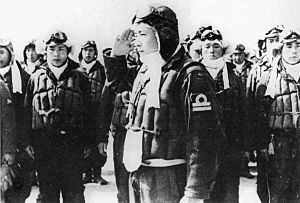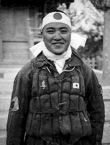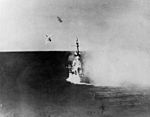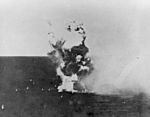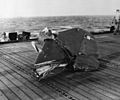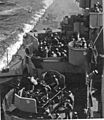Kamikaze facts for kids
The word Kamikaze comes from Japan. It means "god-wind" or "divine wind." This name was first used for a powerful typhoon that destroyed the Mongol fleet trying to invade Japan in the 13th century. This typhoon saved Japan from being taken over.
In many Western countries, Kamikaze is now used to describe the Japanese suicide pilots from World War II. These pilots flew their planes directly into Allied ships during the last years of the war. The word has also come to mean other types of suicide attacks.
Many people in Western countries think the Japanese military called these pilots "Kamikaze." But this is not true. Their real name was tokubetsu kōgeki tai, which means "special attack team." This was often shortened to tokkōtai. The suicide attacks by Navy pilots were called shinpū tokubetsu kōgeki tai, meaning "divine wind special attack team." American translators made a mistake in how they said the Japanese word shinpū (divine wind). They read it as kamikaze, because the Japanese characters can be read both ways. The name became very well known, so after the war, even the Japanese started using it.
Contents
Why did Kamikaze attacks start?

After the attack on Pearl Harbor in December 1941, the Japanese Navy and its Air Force lost many important battles. These included the Battle of Midway and the Battle of the Philippine Sea. Japan lost many ships, including almost all its aircraft carriers. They also lost hundreds of fighter planes and many of their best pilots.
Japan's factories were much smaller and poorer than America's. The United States could quickly replace its lost ships and planes with better ones. But Japan could only make a few, and they were often not as good. From 1943 to 1944, the Allied forces moved closer to Japan. In the Battle of the Philippine Sea in June 1944, Japanese forces were pushed back to the Philippines.
On July 15, Allied forces captured Saipan. This island in the Northern Mariana Islands allowed American B-29 Superfortress bombers to attack Japan itself. After Saipan fell, Japanese commanders knew the Allies would try to capture the Philippines next. The Philippines were very important because they were between Japan and the oil fields of Southeast Asia. If Japan lost the Philippines, they would have very little fuel for their ships. On October 17, the Allies began their attack on the Philippines in the Battle of Leyte Gulf.
How the Special Attack Unit was formed
Vice Admiral Takijirō Ōnishi was in charge of the Japanese Air Force in Manila. He knew that it was impossible to win the battle with so few aircraft and trained pilots. Because of this, he decided to create a suicide attack force. He called it the Special Attack Unit.
A group of 24 student pilots volunteered for this dangerous mission. The Special Attack force was divided into four groups: Unit Shikishima, Unit Yamato, Unit Asahi, and Unit Yamazakura. These names came from a patriotic poem written by the Japanese poet Motoori Norinaga. The poem talks about the "Yamato spirit" (the spirit of old Japan) and compares it to mountain cherry blossoms that smell sweet in the rising sun.
First Kamikaze Attacks
The Japanese lost the Battle of Leyte Gulf. However, the Special Attack force had great success. The first kamikaze attack happened on October 21, 1944. It was against the HMAS Australia, a ship of the Royal Australian Navy. Thirty sailors died in this attack, and many more were wounded. By October 26, 47 more Allied ships had been attacked. Most of them were badly damaged or sunk, like the United States aircraft carrier USS St. Lo.
This early success made Japanese commanders decide to continue the kamikaze attacks. Many more pilots were recruited. Over the next few months, more than 2,000 planes made such attacks. When Japan started running out of good airplanes, they built new, low-quality models just for these missions. Some planes, like the Nakajima Ki-115 Tsurugi, were made mostly of wood and used old engines. The pilot would drop the plane's landing gear after takeoff so it could be used again, since he would not be landing. Other suicide attack programs were also planned, including rocket bombs with pilots called Ohka and submarine torpedoes called Kaiten.
The most intense period of kamikaze attacks was from April 6 to May 25, 1945, during the Battle of Okinawa. This was called Operation Kikusui, meaning "floating chrysanthemums." During this time, seven major waves of attacks happened, with over 1,500 kamikaze planes.
Because their training was very short and their airplanes were poorly made, kamikaze pilots were easy targets for the experienced Allied pilots. The Allies also had much better planes. But still, the kamikaze pilots who got past the anti-aircraft fire and enemy fighter planes caused great damage to the Allied fleet. The Allies won the battle, but they lost many ships and men because of kamikaze attacks. By the end of the battle, at least 21 American ships had been sunk by kamikazes. Some ships from other Allied navies were also sunk, and dozens more were damaged.
Hundreds of extra kamikaze planes were ready to defend Japan from invasion. However, Japan surrendered on August 15 after the atomic bombings of Hiroshima and Nagasaki. The Soviet Union also declared war on Japan. So, these planes were never used.
What were the effects of Kamikaze attacks?
The most important effect of the attacks was creating fear among the Allied troops. When American ships went to the last battles, the crews were very afraid of kamikaze pilots.
By the end of World War II, the Japanese Navy had lost 2,525 kamikaze pilots, and the Air Force had lost 1,387. The Japanese government said that these missions sank 81 ships and damaged 195. They also claimed that kamikaze attacks caused 80% of Allied deaths in the last years of the war.
American sources claim that kamikazes sank fewer ships than the Japanese said. But they still agree that the attacks caused very important damage. According to the United States Air Force, kamikaze attackers sank 34 Navy ships, damaged 368 others, killed 4,900 sailors, and wounded over 4,800. In a 2010 book, historian Robin Rielly said that about 60 U.S. ships were sunk by kamikazes, and over 400 were damaged.
What did Kamikaze pilots believe?
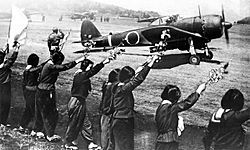
Many kamikaze pilots volunteered for the mission. They were usually very young, between 18 and 24 years old. They believed that dying while striking down Japan's enemies and the Emperor of Japan was a very honorable death. This idea was traditional since the days of the samurai. It gave great importance to duty and obedience. This idea was called Giri, meaning "Obligation." It was part of the code of conduct for Japanese warriors since the Middle Ages, known as Bushido. Many young men sacrificed themselves willingly because these beliefs and their love for their homeland were the most important things to them. The tokkōtai pilot's manual told pilots to never close their eyes. This was so they would not miss their target. In the final moments before the crash, the pilot was told to shout "Hissatsu!" (meaning "Critical Strike!") as loud as he could.
However, many others volunteered because of social pressure. Not volunteering was seen as a sign of cowardice and dishonor. Some professional pilots who were ordered to do suicide attacks did it because of military obedience, not because of honor. One of the first kamikaze pilots, Lieutenant Yukio Seki, wrote after almost being forced to volunteer:
- Japan's future is pale if it is forced to kill one of its best pilots. I am not going on this mission for the Emperor or for the Empire... I am going because I was ordered to.
A special ceremony usually took place before pilots went to combat. Pilots drank sake and ate a ball of rice. They were given medals and a katana sword. They put on a headband with the rising sun, and a sennibari, which was a "belt of a thousand stitches" made by a thousand women, each making one stitch. Many times, they took prayers written by their families with them.
According to legend, young pilots on kamikaze missions often flew southwest from Japan over Mount Kaimon, which is about 922 meters (3,000 feet) high. Suicide mission pilots looked over their shoulders to see this mountain and said farewell to their country. Another legend says that kamikaze pilots dropped flowers from the air as they left on their final missions. Some places, like the hills near Kikajima airport, are said to have beds of cornflowers that bloom in early May from those days.
Some important military men who survived the war later criticized the kamikaze plan. Saburo Sakai, a famous pilot during the war, said:
- A kamikaze is a surprise attack, according to our ancient war tactics. Surprise attacks will be successful the first time, maybe two or three times. But what fool would continue the same attacks for ten months? Emperor Hirohito must have realized it. He should have said "Stop."
Related pages
Images for kids
-
The Mongol fleet destroyed in a typhoon, by Kikuchi Yōsai, 1847
-
An Mitsubishi A6M Zero plane flying towards the escort carrier USS White Plains on October 25, 1944. The aircraft exploded in mid-air moments after this picture was taken.
-
USS Missouri shortly before being hit by a Mitsubishi A6M Zero (visible top left), April 11, 1945
See also
 In Spanish: Kamikaze para niños
In Spanish: Kamikaze para niños


